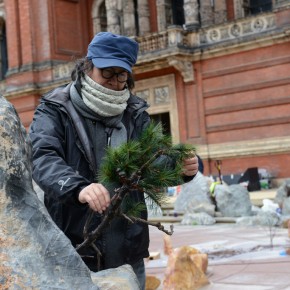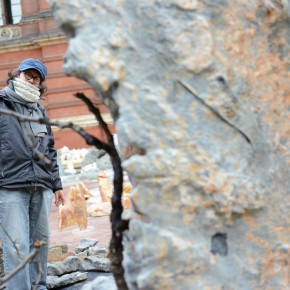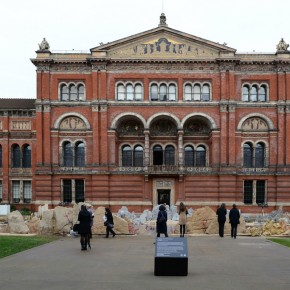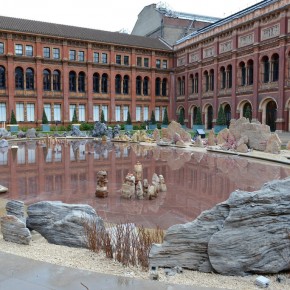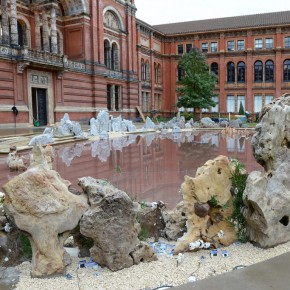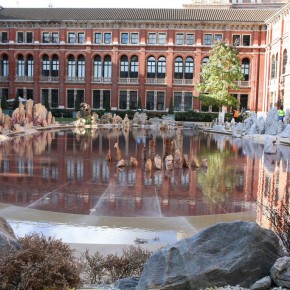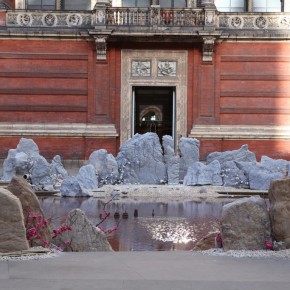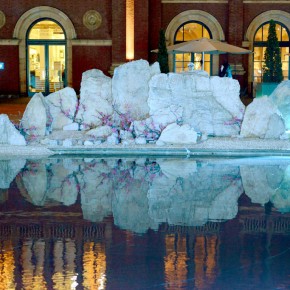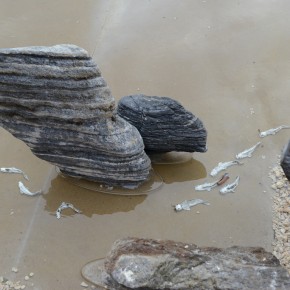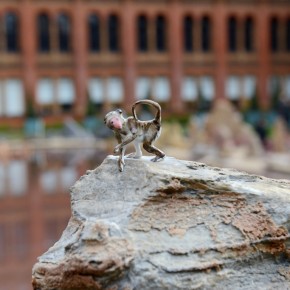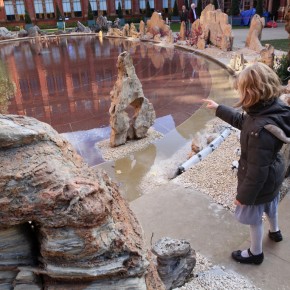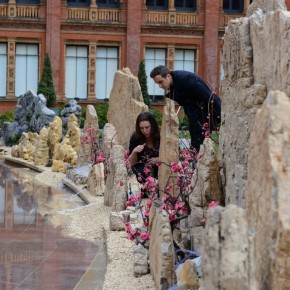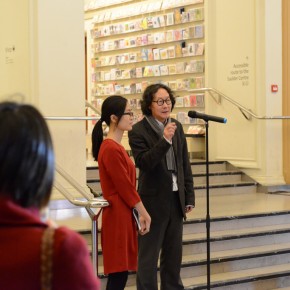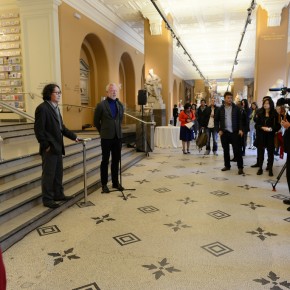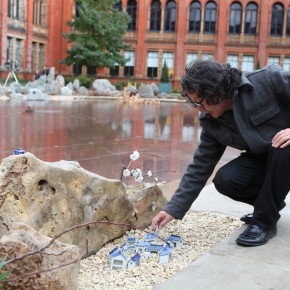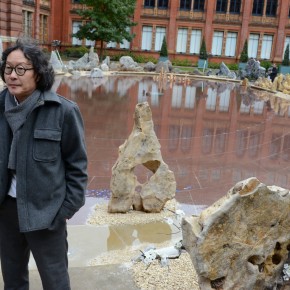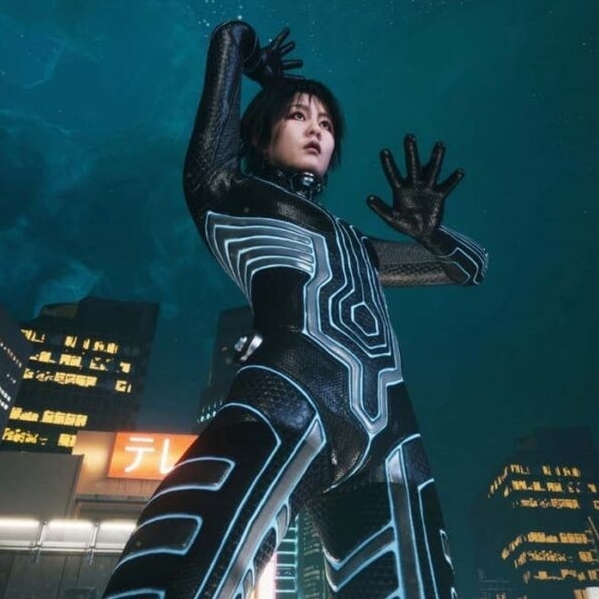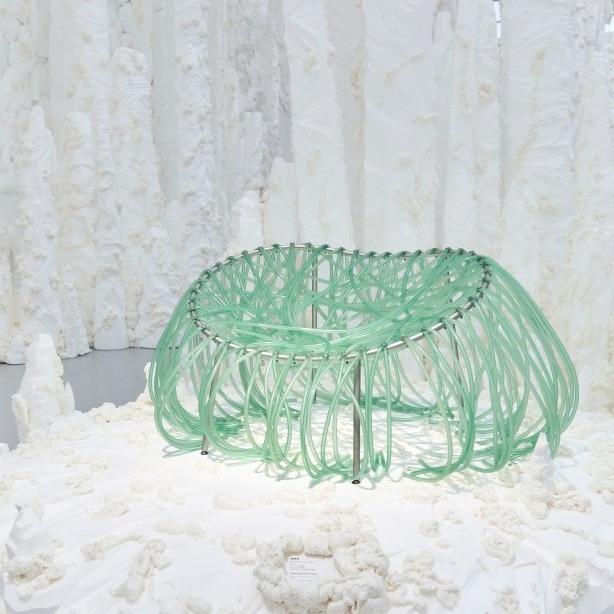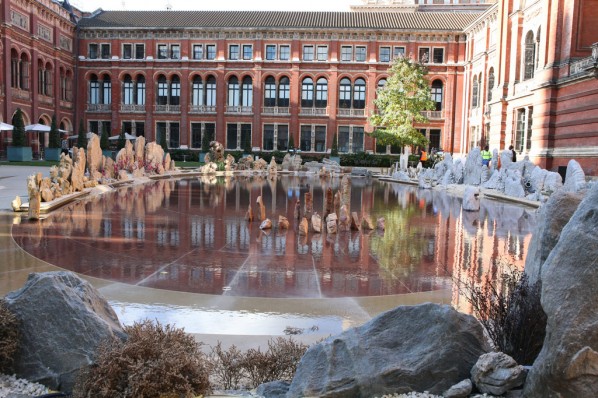
The newest work by Xu Bing entitled “Travelling to the Wonderland” is unveiled at the Victoria and Albert Museum in London. “Tao Hua Yuan”(Peach Blossom Spring), a reclusive aspiration of ancient Chinese literati, is the combination of Taoism and Confucianism, as well as a harmonious realm between Man and Nature, among human beings, further it is an unattainable utopia. In the opinion of Xu Beijing, this is not only the ideal of ancient Chinese literati, but it is his own ideal, which also belongs to all human beings from different countries, that’s why he firmly entitled the work : Travelling to the Wonderland!
The Victoria and Albert Museum (often abbreviated to the V&A) in London is the world’s greatest museum of art and design. It attracts worldwide attention for its historical architecture and enormous collection. Officially opened by Queen Victoria in 1857, the V&A Museum has a central garden redesigned by Kim Wilkie and opened as the John Madejski Garden in 2005 among its redbrick architecture, there is an elliptical water feature lined with stones with steps around the edge which may be drained so the area can be used for receptions, gatherings or exhibition purposes. In London which is the foremost industrial city, this garden with a pond of blue water has become Xu Bing’s “Wonderland”. This site-specific project seemed to be a challenge for Xu Bing, an opportunity as well, since the challenge and difficulty brought by the specified conditions usually push his thinking further, which in turn result in a more profound exploration.
“Travelling to the Wonderland” is one of the largest work Xu Bing has created in recent years. The main body of this dream-like landscape is a 100-meter long installation created around the central water feature of the John Madejski Garden, built on with 9 layers of ceramic and thinly-cut stones collected from five different places in China, the total weight being over 60 tons. Featuring local geographical characteristics, these stones counterpoint (or reflect) the typical style of ancient Chinese landscape painting, revealing the source of inherent beauty among Chinese landscape paintings. Here, natural rocks and plants become the brush in the hand of Xu Bing, he leads the audience “as if watching a long scroll painting while visitors are walking in the landscape.” For Xu Bing, Chinese paintings broaden one’s vision over landscapes while giving free rein to one’s thoughts and feeling, the key lies in “travelling”. To achieve this effect, Xu Bing thinned and flattened the natural rocks in his creation, bringing them closer to painting rather than sculpture, meanwhile, he provided them with theatrical effects of scenery to create a “two-and-a-half-dimensional” effect between two-dimensional drawing and reality. With his wisdom, Xu Bing leads the audience to create another dimension of vision between the reality and the virtual world, and inspires the audience to jointly explore the expressive way and artistic language of the Chinese cultural kernel.
In addition to the stones, natural plants, ceramic houses and other scenes are full of idealistic characteristics. Hundreds of ceramic houses, each one specially handmade and coloured to reflect different traditional styles, are placed among the stones, constituting living villages in various styles. Modern elements such as small LCD screens with cartoon animations have also been introduced into the landscape to represent the co-existence of ancient and modern in contemporary China, and present everyday life. Lighting and mist also change the atmosphere of the installation depending on the time of day. Xu Bing is famous for his rigorous attitude towards work, he does his best to make every detail accurate, like an ancient literati, delineating and showing the shades and textures of rocks and mountains by polishing light strokes with exquisite touches. The modelling of ceramic houses in the work has been cast into “the shapes of a rhombus”, organically integrated into a “two-and-a-half-dimensional” concept. The styles and colors of the ceramic houses are not arbitrary, instead they are arranged with the landscape refinement and built with stones, such as Taihu stones from the south of the lower reaches of the Yangtze river in China are matched with Suzhou garden-style houses; similarly, the plants and ceramic animals are included too. Not only do they generate a visual beauty of harmony, but they also convey the literary charm. Animated characters are symbolic reference to abstract human beings from the internet and cell phone, in a humorous way, it indicates his life and emotions, arousing sympathy for a better ideal life from the audience.
The misplacement of time and space causes a sense of “unreality”, a seemingly walk-through exhibit, where you can stay and travel, as solemn as a miniaturized stateless world. Mist, light and indistinct sound effects such as the singing of insects and birds, endow this work with dreamlike feelings, while the reality and dreams are constantly switched in turn, what is real and what is fake? “Tao Hua Yuan”(Peach Blossom Spring), such a beautiful Chinese dream, lost after being gained, does it really exist? Or did it never exist before? People keep on pursuing this dream, however, they seem farther and farther from the realization.
A masterpiece written by the scholar Tao Yuanming in 421AD, Tao Hua Yuan describes an ideal land of Chinese literati in which people lead an ideal existence in harmony with nature unaware of the outside world. Although the ideal of Chinese literati that they want to return to nature and a simple life seems different from the western utopia, both of them reflects the introspection of modern civilization in this work. The other half of the title for this exhibition is that “it will definitely come true” is a quotation from Xu Bing with reference to “L'Internationale, Sera le genre humain”( The Internationale, Will be the human race) in The Internationale. Xu Bing thought that in today’s social context, the firm sense “must be achieved” has a sense of irony and metaphor, since human beings have been seeking a better ideal environment, but actually they seem to be farther away from it and it “must be achieved”. “Travelling to the Wonderland” borrows and transforms the image of “Tao Hua Yuan”, bringing today’s audience to art work that lies between sincerity and illusion, between three-dimensional space and two dimensions, projecting their emotions and thinking, thus a kind of comfort for yearning from the bottom of their hearts can be acquired.
“In today’s world, human beings no matter where they live, seem very difficult to find an ideal place to live, almost everyone is dissatisfied with their living circumstance. Contemporary people particularly aspire to a natural, equal and harmonious life without any political induction,” said Xu Bing. In “Travelling to the Wonderland”, we can see that Xu Bing creates an ideal world of multitude with his unique artistic language, you can say this is Tao Hua Yuan, you can say this is the paradise, or it can be said this is the tower of Babel.
Image Courtesy of Xu Bing Studio, edited and translated by CAFA ART INFO.


